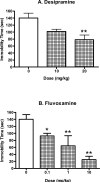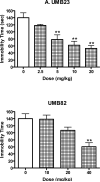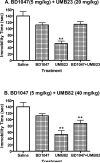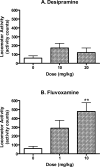Novel sigma (sigma) receptor agonists produce antidepressant-like effects in mice
- PMID: 17376658
- PMCID: PMC4041597
- DOI: 10.1016/j.euroneuro.2007.02.007
Novel sigma (sigma) receptor agonists produce antidepressant-like effects in mice
Abstract
Many antidepressant drugs interact with sigma receptors and accumulating evidence suggests that these proteins mediate antidepressant-like effects in animals and humans. sigma Receptors are localized in brain regions affected in depression, further strengthening the hypothesis that they represent logical drug development targets. In this study, two novel sigma receptor agonists (UMB23, UMB82) were evaluated for antidepressant-like activity in mice. First, radioligand binding studies confirmed that the novel compounds had preferential affinity for sigma receptors. Second, the forced swim test, a well established animal model for screening potential antidepressant drugs, showed that both compounds dose-dependently reduced immobility time. The sigma receptor antagonist BD1047 attenuated the antidepressant-like effects of UMB23 and UMB82. Third, locomotor activity suggested that the effects of UMB23 and UMB82 in the forced swim test were not due to non-specific motor activating effects. Together, the data provide further evidence that sigma receptor agonists represent a possible new class of antidepressant medication.
Figures








Similar articles
-
The synergistic effect of selective sigma receptor agonists and uncompetitive NMDA receptor antagonists in the forced swim test in rats.J Physiol Pharmacol. 2006 Jun;57(2):217-29. J Physiol Pharmacol. 2006. PMID: 16845227
-
Evaluation of sigma (σ) receptors in the antidepressant-like effects of ketamine in vitro and in vivo.Eur Neuropsychopharmacol. 2012 Apr;22(4):308-17. doi: 10.1016/j.euroneuro.2011.08.002. Epub 2011 Sep 10. Eur Neuropsychopharmacol. 2012. PMID: 21911285
-
Pharmacological interaction with the sigma1 (σ1)-receptor in the acute behavioral effects of antidepressants.J Pharmacol Sci. 2011;115(3):279-92. doi: 10.1254/jphs.10191fp. J Pharmacol Sci. 2011. PMID: 21427517
-
A perspective on the new mechanism of antidepressants: neuritogenesis through sigma-1 receptors.Pharmacopsychiatry. 2004 Nov;37 Suppl 3:S208-13. doi: 10.1055/s-2004-832679. Pharmacopsychiatry. 2004. PMID: 15547787 Review.
-
Sigma receptors: potential targets for a new class of antidepressant drug.Pharmacol Ther. 2010 Sep;127(3):271-82. doi: 10.1016/j.pharmthera.2010.04.003. Epub 2010 May 11. Pharmacol Ther. 2010. PMID: 20438757 Free PMC article. Review.
Cited by
-
Sigma-1 receptor knockout mice display a depressive-like phenotype.Behav Brain Res. 2009 Mar 17;198(2):472-6. doi: 10.1016/j.bbr.2008.11.036. Epub 2008 Nov 30. Behav Brain Res. 2009. PMID: 19100292 Free PMC article.
-
Ketamine: The final frontier or another depressing end?Behav Brain Res. 2020 Apr 6;383:112508. doi: 10.1016/j.bbr.2020.112508. Epub 2020 Feb 1. Behav Brain Res. 2020. PMID: 32017978 Free PMC article. Review.
-
Effect of Acute Ketamine Treatment on Sympathetic Regulation Indexed by Electrodermal Activity in Adolescent Major Depression.Pharmaceuticals (Basel). 2024 Mar 10;17(3):358. doi: 10.3390/ph17030358. Pharmaceuticals (Basel). 2024. PMID: 38543144 Free PMC article.
-
Sigma 1 Receptor Antagonists Inhibit Manic-Like Behaviors in Two Congenital Strains of Mice.Int J Neuropsychopharmacol. 2018 Oct 1;21(10):938-948. doi: 10.1093/ijnp/pyy049. Int J Neuropsychopharmacol. 2018. PMID: 29860313 Free PMC article.
-
Mania induced by opipramol.Indian J Psychol Med. 2015 Jan-Mar;37(1):96-8. doi: 10.4103/0253-7176.150852. Indian J Psychol Med. 2015. PMID: 25722522 Free PMC article.
References
-
- Aghajanian GK. In: Essays in neurochemistry and neuropharmacology. Youdim MBH, Lovenberg W, Sharman DF, Lagnado JR, editors. Vol. 3. John Wiley and Sons; New York: 1978. pp. 1–32. - PubMed
-
- Alonso G, Phan V, Guillemain I, Saunier M, Legrand A, Anoal M, Maurice T. Immunocytochemical localization of the sigma-1 receptor in the adult rat central nervous system. Neuroscience. 2000;97:155–170. - PubMed
-
- Aydar E, Palmer CP, Klyachko VA, Jackson MB. The σ receptor as a ligand-regulated auxiliary potassium channel subunit. Neuron. 2002;34:399–410. - PubMed
-
- Beique JC, Blier P, de Montigny C, Debonnel G. Potentiation by (−)pindolol of the activation of postsynaptic 5-HT1A receptors induced by venlafaxine. Neuropsychopharmacology. 2000;23:294–306. - PubMed
Publication types
MeSH terms
Substances
Grants and funding
LinkOut - more resources
Full Text Sources
Medical

